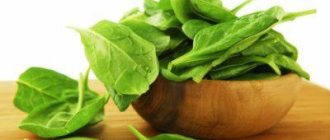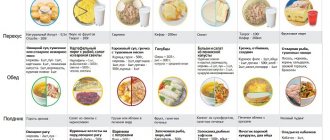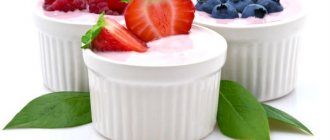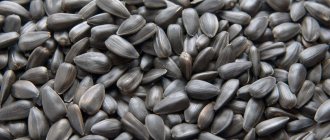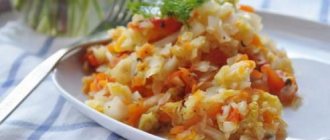Hello, dear readers of my blog! Today I want to talk to you about the benefits and harms of fruits during breastfeeding. Having given birth to a baby, we think about what fruits can a nursing mother of a newborn eat? This question arises because of the panicky fear of harming your baby, as well as because of many myths.
Grandmothers and neighbors constantly try to scare the new mother with the fact that she should not eat anything but apples, otherwise the child will become covered with a rash and spots. Let me tell you right away, it’s not all bad! In this article we will figure out which fruits should really be avoided, and which, on the contrary, are healthy.
Why are some products not allowed?
In the first month of breastfeeding, a woman should be especially careful when choosing foods. Molecules of nutrients enter breast milk, and with it, during feeding, into the baby’s digestive system. In a child’s fragile body, foreign substances can provoke various reactions.
All babies react differently to their mother's nutrition. The first month of life is a special period during which the child’s digestive system is most vulnerable. Many fruits, as well as vegetables, can provoke eating disorders and allergic reactions in a child during breastfeeding. Which of them can be consumed without danger, and which ones should you hold off on?
The fact is that any fruits and vegetables in large quantities at the initial stage of feeding, due to the content of difficult-to-digest fibers in them, can cause bloating and eating disorders in mother and child. Therefore, first of all, it is worth limiting the amount of fruits and vegetables you eat .
In total, they should make up no more than 1/4 of a woman’s daily diet. If measured in quantitative terms, you should not consume more than 700 g of vegetables and 300 g of fruits per day.
With caution: which fruits are best avoided during breastfeeding
There is no need to completely give up all fruits - the baby should receive all the necessary vitamins and minerals through mother's milk. But it is necessary to “sort” for the first six months after birth so that the baby does not receive the lion’s share of allergens along with the mother’s diet. They threaten considerable trouble for the baby.
- Bright citrus fruits can change the taste of milk for the worse and the baby may refuse to breastfeed. Also, tangerines, oranges, grapefruits are strong allergens.
- Cherries, cherries and currants are useful, but can provoke an allergic reaction and rash in infants. Delay their inclusion in the diet until the child is 10-12 months old.
- Grapes can cause intestinal colic. If you decide to try a few grapes, make sure they are washed thoroughly. It is better if the grapes come from your garden plot.
Safe fruits
By region of origin
If we talk about which foods are better absorbed, then, naturally, these will be those fruits and vegetables that grow in the region where they live. This is where you can start experimenting with your diet to find out the child’s reaction.
The human digestive system may not have specific enzymes that break down substances contained in products that are not typical for the region of residence. Any large undigested molecules can cause indigestion and allergies. That is why in the first month of lactation it is better to give up exotic fruits and start trying them no earlier than when the child turns 4 months old.
According to the principle of cultivation and storage
There are no questions about fruits and vegetables collected from your own plot. Most likely, they were grown without the use of chemical stimulants, and therefore are at least not dangerous to health. The situation is different with store-bought products.
You can buy any fruits and vegetables in stores all year round. The fact is that most fruits are treated with chemical compounds for better preservation during transportation.
The substances used for processing prevent the occurrence of rot, mold, and the proliferation of insects, and provide the fruit with an attractive presentation. Most of them contain phenols, nitrates and sulfur compounds that are hazardous to human health. That is why fruits purchased in the store must be thoroughly washed, or better yet, peeled.
How to choose correctly
In order not to expose herself and her child to the risk of poisoning, it is advisable for a nursing woman to choose seasonal fruits that grow close to the region where they live and that have not been subjected to long-term storage and long transportation.
To summarize the above, we can determine which fruits are safe to eat in the first month of breastfeeding:
- Hypoallergenic - non-brightly colored, white and green fruits.
- Typical for the region of residence.
- Seasonal - those that have time to ripen in the region of residence by the time of sale.
Safe fruits include:
- Apples. They can be eaten in limited quantities, since due to their high iron content, apples can cause constipation in the mother or child.
- Pears. They are also not recommended to be abused, since in large quantities they can cause intestinal colic.
- Plums. Despite their intense coloring, they are hypoallergenic, but have a pronounced laxative effect. It is better to prefer dried fruit compote to fresh plums.
- Peaches and apricots are not highly allergenic. They can be eaten in limited quantities during the first month of feeding.
- Banana. Despite the fact that it is not a typical product for Russian regions, banana is low allergenic. When feeding, you can eat it without fear for the baby’s health.
To reduce the negative impact of fruits on digestion, it is advisable to eat most of them after peeling them.
How to properly consume fruits during lactation
There is an opinion that a breastfeeding woman cannot do anything at all; the desired goodies are considered harmful. In fact, a lot is possible, the main thing is to approach everything wisely and know when to stop. Fruits are one of the types of foods rich in vitamins and nutrients, so their consumption cannot be completely excluded. It is worth following a few simple recommendations so as not to harm the newborn’s body. Useful tips on “how to eat fruit correctly during pregnancy” are as follows:
- Of course, a nursing mother will not eat only green apples and bananas, so if you want to try some new fruits, then you should introduce them into your diet gradually, one small piece a day. Then it will be easy to see the negative consequences in the baby and not harm his health;
- The ingredients that the mother consumes while breastfeeding should be chosen of high quality, fresh and appropriately processed. So, for example, exotic fruits are often subject to additional treatment with chemicals that must be thoroughly washed off before consumption;
- a portion of fruit should not be the main dish; it is better to replace dessert with it after lunch;
- a little of a good thing, as they say, so you shouldn’t go heavy on the fruit right away. Often, allergic reactions in infants can appear as a result of prolonged use by the mother of the same product as a result of a cumulative effect. If the baby tolerated the first piece well, then the fruit should be introduced further, gradually.
Vegetables in the diet
Vegetables must be included in the diet of a nursing woman. You should choose them based on the same principles that are used when choosing fruits.
In the first month, it is better to exclude brightly colored tomatoes, carrots, eggplants and beets from typical vegetables. Instead, you can eat stewed zucchini, potatoes, broccoli, and cauliflower.
Fresh vegetables must be present in the diet. What vegetables can you eat during the first month while breastfeeding without fear for the baby’s health? Lettuce, dill, parsley, white and green bell peppers, and green beans will enrich a woman’s diet with valuable microelements and are unlikely to cause a reaction in the child.
Among typical vegetables, it is worth highlighting white cabbage. It is better to completely abandon this undoubtedly useful product in the first month of feeding. White cabbage, along with legumes, is the most powerful provocateur of eating disorders in infants in the first month of life. Its consumption in fresh and stewed form can be done with caution, starting no earlier than the time when the child is 3-4 months old.
After some time, observing the child’s reaction, the mother can gradually expand her diet, periodically including new foods. At the initial stage, it is better not to take risks, but to include in your menu only vegetables and fruits allowed in the first month of feeding.
Is it possible to have berries?
If you eat berries during breastfeeding, then only from your garden!
Juicy, delicious, tender berries will saturate a nursing mother’s body with simple natural sugars and will not spoil her figure. They contain a lot of vitamin C, K, PP and folacin. They will improve the absorption of iron, enrich it with minerals and microelements that she needs so much during lactation. The aromatic pulp will regulate intestinal function, promote digestion, strengthen the immune system, and cleanse the body of poisons and toxins.
Many people are afraid to eat berries while breastfeeding because of their brightness, but most of these fruits are harmless and do not cause allergies. The main thing is to consume them strictly in season, do not buy early berries, which contain a lot of nitrates. There is no need to pounce on a whole plate of fresh, aromatic fruits after a long abstinence from fresh foods. They are eaten little by little, monitoring the baby’s reaction.
The introduction begins with yellow, green or white fruits (yellow raspberries, white currants, gooseberries, green grapes) no more than 5 pieces. in a day.
It is important to pour boiling water over the fruits in order to destroy traces of parasites and microbes. If the baby does not have rashes or irritations, you can introduce dark berries: strawberries, sea buckthorn, strawberries, raspberries, shadberry, blueberries. Heat-treated fruits will also retain their properties in compotes, desserts, and pies. It is better to eat fresh fruits after breakfast, mixing them with cottage cheese or kefir.
Some foods can significantly increase the fat content of breast milk, causing it to become thick and causing your baby to refuse the breast.
When asked which berries are best for a nursing woman to consume, pediatricians will answer – those that the body requires. The mother's intuition and desire are the main factors to pay attention to. If grandmother and husband say that mommy should eat an apple, but she cannot look at it, dreaming of strawberries, the choice is obvious. Two fragrant berries will be much healthier for her than the most fortified apple.
Caution of a nursing mother
Fruits and berries are indispensable on the table during breastfeeding. But what is important here is not the choice of the fruit itself, what color and size it is, but when it is ripe and where it is grown. The ideal option would be fruits grown in your own bed and in your garden. Then we can confidently say that they will bring 100% benefit to both mommy and baby. And if a mother buys strawberries in December, she is unlikely to be able to provide her child and herself with vitamins and minerals without being endangered.
Important! Fruits and berries should be consumed in season and purchased only from trusted sellers.
New foods, including juices and compotes, should be introduced into the diet gradually and not in the first month after birth. At the beginning of the day, eat a small piece or 2-3 berries, then carefully monitor the baby’s condition. If the fruit is well absorbed by the baby, you can safely increase the dose. But if the mother herself does not tolerate any fruit, and relatives say that it is very healthy, you should not forcefully eat it.
Each organism is individual, and if one baby tolerates strawberries and persimmons well, another may even be overwhelmed by a green apple. Therefore, the mother herself must figure out which fruits will be useful for her and the baby, and which ones will not.

